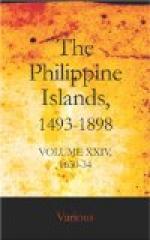[86] This was Balthasar Carlos, born in 1630; he died in 1646. He was betrothed to Mariana of Austria, but his father, Felipe IV, married her in 1649.
[87] In 1552 Felipe II ordered a royal monopoly on playing-cards to be established throughout his western dominions. All cards were to be stamped with the royal arms. The manufacture and sale of them was sold in 1578 to Hernando de Caseres, who paid a royalty of one real for each pack. The value of the privilege gradually increased as well as the price of cards paid by the public. (Bancroft’s History of Mexico, iii, pp. 663, 664.)
This monopoly was established in the Philippines in 1591, by Gomez Perez Dasmarinas; see Vol. VIII, pp. 169, 271; and IX, p. 62.
[88] Apparently a reference to the capture of the Japanese junk by Spaniards, frequently referred to in previous documents.
[89] The Oriental commerce of Denmark began with the despatch of an expedition in 1618 to open trade with Ceylon. Being unfavorably received there, the Danes went to the Coromandel coast of India, and founded a trading-post at Tranquebar, one hundred and forty miles southwest of Madras, defended by the fortress of Dansbourg. For some time this post and its trade had considerable prosperity, but European wars prevented its fitting support and the commercial company was unable to maintain it. In 1670 a new company resumed this enterprise, but was even more unfortunate than the other, and finally expired in 1730. Two years later a third company was formed, which was liberally endowed with privileges and subsidies, and was highly successful. Tranquebar remained in possession of Denmark until 1846, when it was purchased by England.
See account of this colony and the Danish trade in the East, in Establecimientos ultramarinos de las naciones Europeas, by Malo de Luque (Madrid, 1784-90), iv, pp. 9-31. See map of “District of Tranquebar,” in Bellin’s Atlas maritime, iii, fol. 36.
[90] This was Father Jeronimo Medrano; he was again elected to the dignity of provincial in 1641 and in 1650.
[91] Christoval Ferreira was born in Portugal, in 1580. At the age of sixteen he entered the Jesuit order, and in 1609 was sent to the Japan mission; he remained there through many years of persecution, and was long the provincial of his order in Japan. In 1633 he was seized and imprisoned, and finally, under the strain of cruel tortures, recanted his faith—being, it is claimed, the only Jesuit who in all those fierce persecutions, became an apostate. His life was spared, but he was compelled by the Japanese to witness the martyrdom of his brethren, and even to decree their fate. At last Ferreira, tormented by remorse and shame, surrendered himself to the authorities as being still a Christian, and died (1652) as a martyr, suffering long and extreme torments. See Cretineau-Joly’s account of his career, in Hist. Comp. de Jesus, iii, pp. 161-164.




